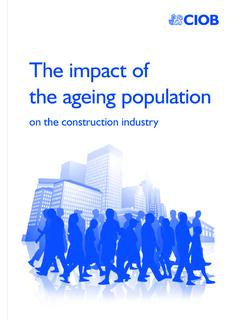Transcription of The Global Impact of Biophilic Design in the Workplace
1 HUMAN SPACES: The Global Impact of Biophilic Design in the Workplace Should a work' place be any different from the other spaces people inhabit? The relationship between individuals and their environment can be a crucial determinant of how they feel, perform and interact with others. So, designing spaces that inspire, energize and support the people who use them is a Global imperative. People's connection to nature biophilia is an emergent field that can help organizations meet that challenge. This unique study explores the relationship between psychological well-being, work environments and employee expectations on a Global scale for the first time. Report Guide Preface From Bill Browning 4. Opening Message From Professor Sir Cary Cooper 5. Biophilic Design at Work 6.
2 The Case for Biophilic Design 11. Global Urbanization 9. Global Research into Biophilic Design 14. Psychological Responses 17. The Impact of Biophilia 18. 1. Well-being 19. A Window On the World 23. 2. Productivity 25. Presenteeism in the Workplace 29. 3. Creativity 30. Summary 33. Key Messages 36. Appendix 38. Appendix One Summary of Global Findings 39. Appendix Two Summary of All Cross Country Findings 41. Appendix Three Reference List 44. HUMAN SPACES: The Global Impact of Biophilic Design in the Workplace | 3. Preface It is an exciting time in the history of Design , a time in which new science is informing our choices to improve people's experience of the built environment. Professor Sir Cary Cooper and his team at Robertson Cooper have a track record of expanding our collective understanding of how to create the best possible workplaces.
3 This study undertaken by Robertson Cooper adds further strength to our understanding of how reconnecting people to nature in the built environment improves well-being and productivity. While many of the responses to Biophilic Design are universal human reactions, this work also highlights some of the subtle cultural differences in these responses. This study is another valuable contribution for supporting the important practise of Biophilic Design . Bill Browning, Founding Partner of Terrapin Bright Green, and one of the green building industry's foremost thinkers and strategists 4 | HUMAN SPACES: The GlobaI Impact of Biophilic Design in the Workplace Opening Message From Professor Sir Cary Cooper This new research report is an important and practical piece, showcasing for the first time the universal connectivity of humans with their natural and built environments.
4 As well as enabling organizations to make links between their physical spaces and the performance of their people, this study throws light on some of the cultural differences at work across the world, and offers an answer to one of the defining factors of modern life our ability to cope with urbanization and loss of connection with green spaces. The backdrop to this report is both the movement of populations from rural to urban environments, and the psychology of work what do we expect and need, and are those expectations different from country to country, organization to organization? The new findings revealed in this report, about how nature and Biophilic Design Impact our well-being, productivity and creativity at work, are significant. But I hope of equal significance is that this report can inspire business owners and commercial designers to take a new approach and prompt everyone to think about their own unique Workplace and how best it can support people to thrive.
5 Professor Sir Cary Cooper, CBE, Professor of Organizational Psychology and Health at Lancaster University, and leading expert on well-being and stress at work HUMAN SPACES: The Global Impact of Biophilic Design in the Workplace | 5. HUMAN SPACES: Biophilic Design at Work Biophilic Design at Work Biophilia, a concept first popularized by Edward O. Wilson in 19841, describes the innate relationship between humans and nature, and concerns the need we have to be continually connected to nature. Plenty of research confirms this human preference for the natural, rather than built, environment2. For example, in a 2004 study, when asked to describe their ideal city, people more often chose non-urban characteristics, greenery in particular3, and in other studies it has been shown that a pleasant and natural view can raise the price of a house considerably4.
6 Although it has been proposed that this desire for a connection with nature is the result of an anti-urban bias combined with a romantic view of nature, environmental psychology research tells us that being connected to nature, is in fact, an adaptive human function that allows for, and assists with, psychological restoration5. This means that within an urbanized environment, bringing in elements that allow direct nature connection (such as parks and lakes) or indirect connections ( , interior Design using natural elements, nature-resembling colors and patterns, indoor plants and views of greenery). can help us to mentally recover and provide respite from our day-to-day activities, to maintain positive well-being. Interest in biophilia has grown substantially over the last decade, largely due to the rapid urbaniziation of the modern world, which has resulted in cities that are characterized by a predominance of manmade structures.
7 Global figures show this incredible shift in populations moving into urban areas over the last 60 years. Some countries, including those we have analyzed in this report, have seen an increase of over 40% in the number of individuals in the population residing in urban areas since 1950. In particular, those countries that have seen the greatest economic development in recent years appear to be the nations with the greatest increase in urbanization such as Brazil (51%), Indonesia (42%), the Philippines (39%). and China (32%). Globally, it is clear that people are moving away from rural areas to towns and cities. In fact, the United Nations predicts that by 2030, 60% of the world's population will live in urban environments. Therefore, it is imperative that we consider how the human-nature connection can still be provided to those residing in towns and cities.
8 The answer to this challenge is Biophilic Design . Often, we find that our cities and suburbs have been designed in a way that alienates us from nature and degrades the environment. Biophilic Design is a method of designing the places in which we live and work in such a way that satisfies our deep and fundamental need to be connected with nature. The effects of providing this connection to nature go much further than simple employee satisfaction. An increasing research base has identified the positive benefits of Biophilic Design in supporting multiple organizational outcomes, including well-being, productivity and creativity. The focus of this report is on the potential benefits to be gained by satisfying humans' Biophilic needs in the Workplace , as well as the issues that surround working in environments that do not provide a connection with the natural world.
9 Following an EMEA (Europe, Middle East & Africa) Human Spaces report published in 2014, which analyzed original data across eight countries in the region and looked specifically at the Impact of Biophilic Design in that geographical area, a second wave of data collection has provided the base for a Global research project. Collecting data from 16 countries around the world, this research quantifies the benefits of Biophilic Design in the Workplace . While adding to the existing evidence base for Biophilic Design , we aim to provide a blueprint for nature-inspired Design for high-performing organizations. HUMAN SPACES: The Global Impact of Biophilic Design in the Workplace | 7. Biophilic Design at Work Research Methodology & Sample Profile Online survey of office workers across a variety of roles and sectors.
10 7600 employees from 16 countries across the world - United Kingdom (UK), France, Germany, Netherlands, Spain, Sweden, Demark, United Arab Emirates (UAE), United States (US), Canada, Brazil, Australia, Philippines, India, China and Indonesia. Largest proportion of respondents fell in the 25-44 age bracket (58%). Largest proportion of respondents spent 40-49 hours a week at work (40%). 39% felt 80-100% productive at work during the last three months. Well-being refers to the combination of participants' responses to three scales: happy; inspired; and enthusiastic. These scales are taken from Robertson Cooper's market-leading stress evaluation tool (ASSET). 8 | HUMAN SPACES: The GlobaI Impact of Biophilic Design in the Workplace Biophilic Design at Work Global Urbanization The table below highlights the increases in the amount of people living in urban areas during the last 60 years across the 16 countries investigated in this report.




